5 Lesson Plans
This handbook has described the rationale and process that will help you bring translation into your language teaching landscape. With translation in the world language classroom, your students will benefit from a new tool that will help them mediate between languages and cultures. So the handbook ends with a starting place for you. This final section includes five lesson plans for translation activities which you can use in your classroom, beginning with the two activities which were explained in detail in the Examples section. The lessons are as follows:
1. Translation of proverbs
2. Slogans and marketing
3. Research questionnaire: ¿Qué tipo de música prefieres?
4. Medical intake interview
5. Bilingual editions of children’s books
Lesson Plan 1: Translation of Proverbs
Objectives
Students will use translation to be able to
- Identify the underlying message in Spanish proverbs
- Explain how proverbs are related to cultural perspectives
- Use proverbs in English and Spanish to make cultural comparisons
Standards
- I can identify the underlying message in Spanish proverbs.
- In my own and other cultures, I can explain how proverbs are related to cultural perspectives.
- I can use proverbs in English and Spanish to make cultural comparisons.
Prior knowledge
Present tense, present and past participles, object pronouns
Levels
High school Spanish, year 3
Materials
Cultural comparison worksheet with list of proverbs in Spanish and columns for literal translation, meaning, and cultural comparison for proverbs (1 per student) (Appendix 1.1)
List of proverbs in English and Spanish (cut up,1 per each group of students) (Appendix 1.2)
Procedures
- In English or Spanish, ask students what they think of when they hear the word “proverb”. Have them discuss their thoughts in their groups, then volunteer to share with the class.
- Discuss proverbs as short sayings which express truths or give advice. In step 1 or 2, have students share any proverbs they may think of in English; discuss what they mean. Ask students how much they hear/use proverbs in their everyday lives.
- Tell students they will be doing a translation activity in which they compare a set of proverbs in Spanish with a set of proverbs in English, with the objectives of:
- Identifying the underlying messages in the proverbs
- Explaining how proverbs are related to cultural perspectives
- Using proverbs in English and Spanish to make cultural comparisons
- Give students the worksheet with the list of proverbs in Spanish (Appendix 1.1) and have them do the following:
- Skim the proverbs individually and underline unknown vocabulary, then look up and write in the new terms
- In groups of 3-4, directly translate the proverbs and write the translations in the middle column.
- In the last column, write down (in English or Spanish, depending on comfort level) what they think the proverb means. In other words, what truth is the proverb teaching, or what advice is it giving?
- Once students have completed step 4, give each group a cut-up list of the English proverbs and Spanish proverbs in Appendix 1.2. Students will then match the proverbs in English and Spanish. Circulate to see if the matches are correct. The matching could be made into a competition to see which group can match them all correctly first.
- Introduce the idea of literal and functional translations to the class and have them identify which translations (the ones they did on the worksheet vs. the English equivalents they were given) are which.
- Have students write the English proverb next to the Spanish proverb on the cultural comparison sheet (Appendix 1.1). In their groups, they should discuss cultural similarities and differences between the proverbs, taking notes on the sheets.
- Discuss students’ cultural comparisons as a class.
Closure: Think, then discuss (whole class): How do proverbs represent cultural perspectives?
Assessment
Students choose a matching set of proverbs in English and Spanish and 1) write out and illustrate the proverbs on a poster; 2) in writing, explain cultural similarities and differences between the proverbs.
Enrichment
This activity could be used as a lead-in to a fable unit, as proverbs are frequently used as the moral of fables. Students could learn about the characteristics of fables, be presented with a selection of fables by various authors (e.g. Samaniego, Iriarte), then taught to distinguish between authors’ styles. For assessment, students could choose a proverb around which to write and illustrate an original fable in Spanish. A selection of fables could be laminated and donated to a local children’s organization.
Appendix 1.1
| Refrán | Traducción | Significado | Comparación Cultural |
| A lo hecho, pecho
|
|||
| Más vale pájaro en mano que cien volando
|
|||
| A quien madruga, Dios le ayuda
|
|||
| Aprendiz de todo y oficial de nada
|
|||
| Al nopal lo van a ver sólo cuando tiene tunas
|
|||
| No todo lo que brilla es oro
|
|||
| Hijo no tenemos, y nombre le ponemos
|
Appendix 1.2
| Don’t count your chickens before they’re hatched |
| Everything that glitters is not gold |
| What’s done is done |
| A bird in hand is worth two in the bush |
| Early to bed, early to rise, makes a man healthy, wealthy and wise |
| Jack of all trades, master of none |
| Choose your friends wisely. |
| A lo hecho, pecho |
| Más vale pájaro en mano que cien volando |
| A quien madruga, Dios le ayuda |
| Aprendiz de todo y oficial de nada |
| Al nopal lo van a ver sólo cuando tiene tunas |
| No todo lo que brilla es oro |
| Hijo no tenemos, y nombre le ponemos |
Lesson Plan 2: Slogans & Marketing
Objectives
Students will use translation to be able to:
- Prepare a marketing campaign in Spanish for a well-known product
After designing their campaign, students will be able to:
- Explain why/how their campaign reflects the practices/perspectives of their target audience
- Explain why/how their campaign is appropriate linguistically for their target audience
- Explain any difficulties they may have had in determining the prior objectives
Standards
- In my own and other cultures I can use a marketing campaign to make comparisons between products and practices to help me understand perspectives.
- I can state my viewpoint on familiar or researched topics and provide reasons to support it, orally and in writing (using a few short paragraphs).
Prior knowledge
- Present subjunctive to make formal and informal commands
- Awareness of linguistic and cultural differences between formal and informal register
Levels
High school Spanish, year 3
Materials
- Internet access
- Computer access (to make a digital marketing campaign and/or to look for products to market in L2)
- Projector & screen
- Slogan/Marketing Campaign assignment (see Appendix 2)
Procedures
Before this lesson, students should have done the following:
- Reviewed and practiced the use of formal and informal affirmative and negative commands.
- Reviewed and discussed examples of marketing campaigns in Spanish that use formal and informal commands. Culturally, what message were the marketers sending when they chose to use formal or informal commands?
Lesson:
- Activate background knowledge: What kinds of marketing campaigns or ads have been particularly effective to you? Can you think of ways their use of language or appeal to culture were particularly effective?
- Discuss the following quotes from Forbes (Mizrahi, 2017) magazine with students:
- “…Consumers don’t want to be exposed to mere translations of messages from English to Spanish; they want to receive messages that reflect their culture.”
- “…the Spanish language alone is not enough to create an effective campaign, we now know that abandoning Spanish to focus only on cultural nuance is not enough.”
- As a class, use the projector to look at several examples of marketing campaigns in English. What types of linguistic and cultural issues have been taken into consideration?
- Slogan/Marketing Campaign: Have students work in their groups to choose a product to market (See Appendix 2).
- After students have decided on their marketing campaign, have them present to the class in groups, using the presentation procedures outlined in Appendix 2.
Enrichment
Students can be asked to compare their campaign with existing campaigns for similar products in the US.
Assessment
A rubric for this assignment is included in Appendix 2.
References
Mizrahi, I. (2017, April 4). Is marketing in Spanish still relevant to Hispanics? Forbes. https://www.forbes.com/sites/onmarketing/2017/04/04/is-marketing-in-spanish-still-relevant-to-hispanics/#53de0347c36b
Appendix 2
Slogan & Marketing Campaign
Scenario: You are part of an advertising agency whose client has recently asked the company to start marketing some of their most popular products to Spanish-speakers in the United States.
Before you create your campaign:
Collect a few examples of campaigns similar to the one you are thinking of creating to use as a resource for comparison. You can use the internet, but make sure you do not use US-based sites as those campaigns may be translated and potentially less authentic.
Questions to ask before you create your campaign:
What product are we marketing and why?
How should the language in the English marketing campaign be changed and why?
Is the English campaign culturally reflective of Spanish speakers? If not, how might the campaign be modified to be more culturally appropriate?
What publication or site will your ad appear in? How will this affect the language and/or graphics you use?
What Spanish speakers in which part of the United States will your ad be targeted towards? How does this affect the language chosen in the ad?
After you have created your campaign:
What, if anything, was difficult about creating this ad in Spanish?
Presentation:
Rubric: Slogan & marketing campaign
| Presentation | Total points: /20 |
| Type of product and reason for marketing is clearly explained How and why English in original campaign should be changed is clearly explained Presentation discusses any modifications made to graphics to be culturally appropriate Publication or site explained, as well as how language and/or graphics are appropriate for that site Target region of US is explained as well as any considerations for text Difficulties in creating ad discussed All group members participated: Y/N Notes: |
/2 /2 /2 /2 /2 /2 /2 |
| Ad | |
| Ad includes 10-15 words of text in Spanish and 1-2 graphics Text is correct |
/4 /4 |
Lesson Plan 3: Research Questionnaire
Objectives
Students will be able to:
- Know and use relevant vocabulary and grammatical structures to write a survey in Spanish, supported by a previously-written survey in English
- Translate a questionnaire they have written in English to ask questions in Spanish about peers’ music preferences
- Orally communicate information about questionnaire subjects’ music preferences, supported by notes and a graph
- Use Spanish orally and in writing to “investigate, explain, and reflect on the relationship between the music and perspectives of the cultures studied” (ACTFL World-Readiness Standards for Learning Languages)
- Understand the communicative connection between the language inside and outside of the classroom
Standards
1.1 Students engage in conversations, provide and obtain information
2.1 Students demonstrate an understanding of the relationship between the practices and perspectives of the culture studied
3.2 Students acquire information and recognize the distinctive viewpoints that are only available through the foreign language and its cultures.
4.1 Students demonstrate understanding of the nature of language through comparisons of the language studied and their own.
4.2 Students demonstrate understanding of the concept of culture through comparisons of the cultures studied and their own.
Prior Knowledge
Present tense
Level
High School Spanish years, 2, 3, 4
General
Review objectives and essential questions with students. Ask them to point out any objectives that might be different from what they might typically be doing in class. How will they know if they have successfully met the day’s objectives?
Essential questions:
- What grammar and vocabulary are necessary to be able to translate a questionnaire on music preferences?
- How should a questionnaire be used to acquire data about peers’ music preferences?
- How can information about music preferences be communicated to a group?
- How do music preferences reflect an individual’s age, gender, language, culture and/or other perspectives?
Procedures
Translation Activity 1
Students will brainstorm types of music genres in groups of 3-4, then look up and record translations. Ask: What do you notice about terms for musical genres that originated in English-speaking areas? In Spanish-speaking areas?
Translation Activity 2
In groups of 3-4, students will create a survey in English and Spanish to determine what types of music their peers listen to and if music preferences are influenced by the language(s) their peers speak.
Direct students:
2.1 Your task is to 1). do a study, and 2). report on the types of music that peers your age listen to.
2.2 In your assigned groups, design a questionnaire in English which does the following:
- Explains the purpose of the questionnaire
- Asks for the following information:
- Age
- Gender
- First language
- Second language (if any) and self-assessed level of proficiency (1-5 scale)
- Mother’s first language
- Father’s first language
- Home language
- Favorite musical genres (include at least eight, including a space for “other”)
2.3 Print or copy the questionnaire. Choose 1-2 people in your group to ORALLY administer the questionnaire to English-speaking (only) friends and acquaintances between 15-28 years old and to write down the responses.
Translation Activity 3
Direct students:
3.1 In your groups, translate the questionnaire to Spanish.
3.2 Print or copy the questionnaire. Choose 1-2 people in your group to ORALLY administer the questionnaire to Spanish-speaking (or bilingual) peers between 15-28 years old and to write down the responses.
Translation Activity 4
Direct students:
Report your results:
4.1 In your groups, create a bar graph in Google Sheets with the following elements:
- Bars for Spanish- and English-speaking participants
- Sections for each type of music
4.2 Groups will present results to the class in Spanish. Each member of the group must speak. Members should plan ahead for who will present which part of the graph.
- For example, each person could describe the results for two types of music. (____ personas que hablan inglés prefieren la música rock, y ___ personas que hablan español prefieren la música rock.)
4.3 Individually, write a paragraph of at least 8 sentences in English summarizing your results. How are the two groups similar or different? Why? Make sure your paragraph starts with a topic sentence, ends with a concluding sentence, and includes specific details to support the points you make. Turn in a printed copy.
Assessment
See sample rubrics for group work, individual paragraph, and for contributions of group members (Appendix 3)
Enrichment
This activity could be incorporated into specific units, e.g. personal and public identity in AP Spanish Language and Culture, or with other songs taught at any level.
Modification
Translation activity 1: Students will brainstorm types of music genres in groups of 3-4, then try to guess the meaning, or look up and record translations. Ask: What do you notice about terms for musical genres that originated in English-speaking areas? In Spanish-speaking areas? Lower-level students can be given a word bank of terns in Spanish and English, match the terms, then choose the genres they would like to use. They can still answer the question about terminology for culturally unique musical genres.
Appendix 3
Rubric: Group work
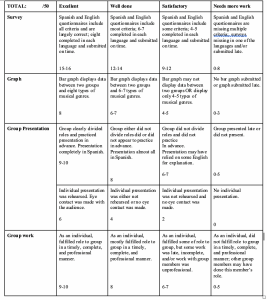
Rubric: Paragraph
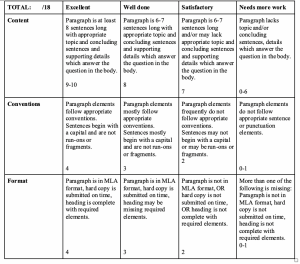
Rubric: Group work (individual group members complete for other members of the group)
Name of group member:
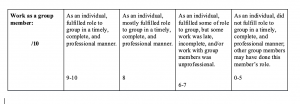
Comments:
Lesson Plan 4: Medical Intake Interview
Objectives
Students will be able to:
- Use a medical intake interview as a context to start and end a conversation and use an appropriate register to ask for information, details, and explanations during a conversation
- Use a medical intake interview as a context to orally provide and obtain information about personal health
- Demonstrate understanding of the nature of culture through comparisons of the language studied and their own through a translation activity involving a medical intake interview
- Demonstrate understanding of the nature of language through comparisons of the language studied and their own through a translation activity involving a medical intake interview
Standards
1.1 Students engage in conversations, provide and obtain information
1.2 Students understand and interpret written and spoken language on a variety of topics; students demonstrate an increasing understanding of the cultural nuances of meaning in written and spoken language as expressed by writers of the target language
3.2 Students acquire information and recognize the distinctive viewpoints that are only available through the foreign language and its cultures.
4.1 Students demonstrate understanding of the nature of language through comparisons of the language studied and their own.
4.2 Students demonstrate understanding of the concept of culture through comparisons of the cultures studied and their own.
Prior Knowledge
Numbers 1-31, days of the week, months
Greetings and introductions
Formal and informal register
Levels
High School Spanish, years 2, 3, 4
General procedures
Discuss the day’s objectives with students. Ask them to point out any objectives that might be different from what they might typically be doing in class. How will they know if they have successfully met the day’s objectives?
Procedures
Translation activity 1
1.1 Brainstorm on the challenges faced by health care encounters or contexts in which the patient does not speak the language of the provider or of relevant health care documents. Ask: Have you ever been in this situation before? Do you know anybody who has?
1.2 Provide a medical history form for a new patient at a doctor’s office written in English.
Translation activity 2
Translation of the form
2.1 Discuss issues of register/specialized terms and how these are relevant to the translation task and audience.
Review register.
In this context, should the relationship between the translator and the audience be formal or informal?
2.2 Have the students translate simple aspects of the form (address, phone number, SSN).
[Comment on the effects of audience, purpose etc. on their translation selection.]
2.3 Have the students translate first names of medical conditions as directed by the instructor and create a glossary.
2.4 What might be some cultural issues or barriers to getting the needed information on this form? (Comment in writing/discuss: illiterate patients who may have no records of the requested information, diseases not discussed, stigma, etc.).
Translation activity 3
3.1 Have students administer the survey in English in pairs, taking turns. (Optionally, the teacher can ask how many people said they had x, y, z and survey the class for commonly chosen diseases. Information does not have to be truthful.)
3.2 What might be some cultural issues or barriers to getting the needed information on this form? (Have students comment in writing and/or discuss) (Examples: Patients who can’t read who may have no records of requested information, diseases not discussed, stigma, patients who do not know English or who do not know it well)
3.3 Repeat #1 with the translated form. One student should play the role of the English-speaking health care provider, another should be a non-English speaking patient, and a third should be a bilingual assistant reading the translated form to the non-English speaking patient.
Students discuss the role of translation in communicating with limited-English proficient patients.
Assessment
Have students show that they can navigate formal and informal registers orally or in writing. They might choose appropriate vocabulary or participate in a simulation that requires a formal or informal register.
Enrichment
This activity might be part of a larger unit on health and well-being or on the challenges of immigration and communication.
Modifications
Year 2, Activity 2, steps 2.2 and 2.3: After discussing register with students, provide them with a multiple-choice list for various options on the medical intake form.
Year 2, Activity 3: Have students share how they might use greetings and/or introductions they know in a formal register to conduct a medical intake interview, then have guests do the role play again in front of the class. Have students comment/write about their experience.
Appendix 4
Instrucciones
- Consider the challenges faced by health care encounters or contexts in which the patient does not speak the language of the provider or of relevant health care documents. Comment on the following:
- Have you ever been in this situation before? Do you know anybody who has?
- Why is the language barrier a problem?
- What are some potential solutions?
- Is this a formal or informal situation? How should the language reflect this?
- What about the specialized terms? Could they be a barrier for communication? How?
- Review the following bilingual intake form. It is a form to be used in a clinic in a southwestern state of the United States. In your groups, provide an appropriate L2 translation where needed. If there is a line next to an English term, a translation is needed. If there is NO line and a L2 word is there, no translation is needed.
Use all resources available to you (dictionaries, similar forms in the target language, etc.)
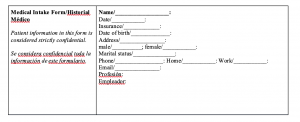
Check ☑and indicate whether the age when you have had any of the following/Marque con ☑ las enfermedades/dolencias que haya tenido:
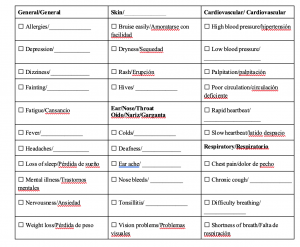
- Administer the questionnaire in English to one of your classmates. They do not have to respond truthfully to the medical questions. Then switch roles.
- What might be some cultural issues or barriers to getting the needed information on this form? (Comment in writing/discuss)
- Observe a role play. One student should play the role of the English-speaking health care provider, another should be a non-English speaking patient, and a third should be a bilingual assistant reading the translated form to the non-English speaking patient.
How is this different from the first one? What are some new roles and how has the patient/provider interaction changed (or not)?
Lesson Plan 5: Translation of bilingual children’s books
Objectives
Students will be able to:
- Use a bilingual text as a context to start and end a conversation and ask for information, details, and explanations during a conversation
- Use a bilingual text as a context to orally provide and obtain information about a culturally relevant topic in Spanish- and English-speaking communities
- Demonstrate understanding of the nature of culture through comparisons of the language studied and their own through a translation activity involving a bilingual text
- Demonstrate understanding of the nature of language through comparisons of the language studied and their own through a translation activity involving a bilingual text
- Write a series of steps needed to complete a task.
- Write a short report about something I have learned or researched.
- Ask for information, details, and explanations during a conversation.
- Be the first to start a conversation; bring a conversation to a close.
- Easily understand the main idea of texts related to everyday life; sometimes follow stories and descriptions about events and experiences in various time frames.
Standards
1.1 Students engage in conversations, provide and obtain information
1.2 Students understand and interpret written and spoken language on a variety of topics; students demonstrate an increasing understanding of the cultural nuances of meaning in written and spoken language as expressed by writers of the target language
2.1 Students demonstrate an understanding of the relationship between the practices and perspectives of the culture studied
3.2 Students acquire information and recognize the distinctive viewpoints that are only available through the non-English language and its cultures.
4.1 Students demonstrate understanding of the nature of language through comparisons of the language studied and their own.
4.2 Students demonstrate understanding of the concept of culture through comparisons of the cultures studied and their own.
Prior Knowledge
Present, past, and future tenses
Levels
High School Spanish, year 3
Sample
Rivera-Ashford, R.C. (2017). My Tata’s Remedies/Los Remedios de mi Tata. El Paso: Cinco Puntos Press.
Enough copies of first page with L2 only for 1 per class group
Procedures
Before reading:
- Activate background knowledge: Discuss the idea of topic (e.g., home remedies) with students. Ask them to share any home remedies they might be familiar with or use in their families.
- Introduce the children’s book, e.g. My Tata’s Remedies/Los Remedios de mi Tata to the students. Give the opening paragraph in the L2 to students in groups of 3-4. Have students scan the paragraph for new vocabulary and look up and record new words.
While reading:
- Have students: 1) Orally read the paragraph in the L2, round-robin style; 2). Write a translation of the paragraph as a class (in a Google doc, on a piece of paper, etc.)
After reading:
- Have all groups put their translations into a Google doc for the entire class. Project the groups’ translations, together with the translation from the book. Compare students’ translations with the book’s translation and discuss their thoughts on how the different translations turned out.
- Copy and give groups eight excerpts in the L2 and English. Have them match the excerpts as quickly as possible, using the L2 (orally) to do so. Groups can compete to see who can finish the fastest.
- Find translations for the remedies.
- Discuss:
- 1) The types of home remedies used in the excerpts and compare to remedies students are familiar with;
- 2) the translation process students used to match the excerpts;
- 3) How the L2 and English translations match up;
- 4) Thoughts or conclusions students have about language and culture after looking at the remedies and/or going through the translation process. Students may discuss these questions in their groups first before sharing out as a class.
Assessment
- Orally assess students for ability to provide information and to begin and end conversations
- Have students reflect in writing on how their understanding of language and culture has changed through the translation activity
Enrichment
Have students research and report on a home remedy used in their own families. They can work alone or in pairs and turn in a written report and/or do a brief oral presentation on their findings.

